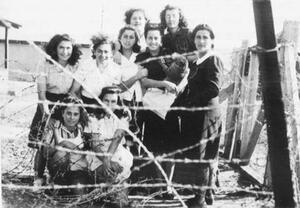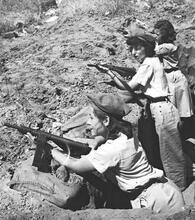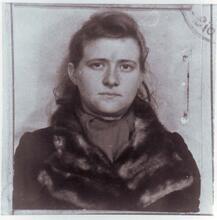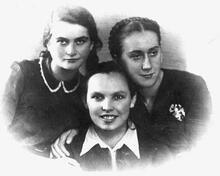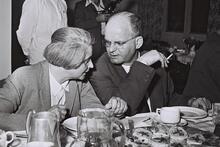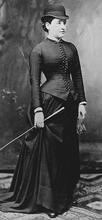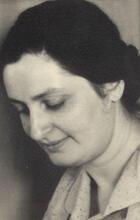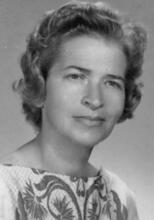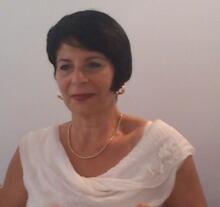Irgun Zeva'i Le'ummi (I.Z.L.)
Courtesy of Yehuda Lapidot.
The women of the underground paramilitary Zionist organization Irgun Zeva’i Le’ummi (known as Irgun) played an important role in group’s violent struggle against British rule and Arab opponents to establish a Jewish state. From the Irgun’s formation in 1931 until the founding of the state of Israel in 1948, women participated in the ideological and “behind the scenes” work of the Irgun, including the distribution of propaganda, the broadcast of Irgun’s radio, and the provision of medical assistance to wounded soldiers, as well as the physical combat and underground attacks planned by the organization.
Background of the Irgun
Following the First World War, the government of Britain was granted a mandate over Palestine by the League of Nations, with the aim of establishing a national home for the Jews. That “National Home,” the Jewish community in Palestine prior to the establishment of the State of Israel. "Old Yishuv" refers to the Jewish community prior to 1882; "New Yishuv" to that following 1882.Yishuv, would later become an independent Hebrew state. However, in May 1939, with the outbreak of the Second World War imminent, the British government issued a “White Paper” banning Jewish immigration to Palestine. “Illegal” immigrant ships that had managed to escape from Europe were barred from entering Palestine and some were even forced to return to Europe, to almost certain death.
The Irgun Zeva’i Le’ummi (known as the Irgun or by its Hebrew acronym Ezel) was a Jewish underground armed organization in Palestine formed in 1931. It was ideologically linked with the extreme nationalist and militant Revisionist movement. In December 1943, when Menahem Begin became the commander of Ezel, relations with the Revisionist movement were severed and the Irgun forged its own political agenda.
On February 1, 1944, the Irgun declared a revolt against the British Mandatory government in Palestine with the aim of establishing an independent Hebrew state where any Jew could find a safe haven. The Irgun rejected the “restraint” policy of the Jewish Agency and the Haganah and opted for aggressive, violent tactics. Two of its most well-known operations include the bombing of the British administrative headquarters in the King David Hotel in Jerusalem in July 1946 and the joint attack with the Lehi on the village of Deir Yasin on April 9, 1848. At this point, it was already clear that an Allied victory over Germany was only a matter of time.
Women’s Participation
No description of the Irgun’s war against the British can be complete without mention of the young women who fought shoulder to shoulder with the men in the campaign to drive the British out of Palestine and in the painful War of Independence that followed. Women took part in every commanders’ training course. Two such courses were intercepted by the British and their participants sentenced to prison terms of various lengths. The first course uncovered by the British, at Mishmar ha-Yarden in December 1939, included four women: Bella Atara-Heitin, Rivka Neuman-Ben-Meir, Ruth Halevi-Nevo, and Chava Kafka-Amrami. They were sentenced to four years in prison, but the commander of the British forces in Palestine did not endorse the verdict and they were released two months later. In the second course, intercepted in Shuni in August, 1945, there were two women participants—Bracha Birnbaum and Devorah Shapira-Rotem—who were sentenced by the British military court to three years in prison.
Upon completion of the courses, the women filled various command posts, some even reaching the senior ranks. Already in the early days of the Irgun, Ra’aya Lieberman was appointed a company commander in Tel Aviv. Not long before the British departure from Palestine in 1948, Devorah Lifshitz became commander of the women fighters in the Tel Aviv district and Emma Germant was appointed commander of the women’s company in Jerusalem. Two Irgun women served as branch commanders: Zippora Perl-Paglin in Safed and Bilha Lederson-Efrat in Rishon le-Zion and later, in Ramat Gan, one of the major branches. One woman, Esther Raziel-Naor, even became a member of the central command of the Irgun.
Propaganda
The Irgun was divided into two major brigades: the Hatam (a Hebrew acronym for Revolutionary Propaganda Force) and the Hok (Fighting Force). Women performed various duties in the Hatam, including pasting posters on the walls of buildings to spread the Irgun’s message. This activity was extremely risky since the British went to great lengths to prevent the mounting of such posters. For example, when Miriam Stutsky was captured in August 1944 with a stack of copies of the Irgun newspaper Herut, she was brought before a military court on charges of possessing illegal material and sentenced to a year in prison. A year later, Amalia Schiff was captured as she was about to circulate posters in Haifa together with her comrade Yehudah Cohen. The two were brought to trial and sentenced to three years in prison.
Women were also involved in distributing propaganda material by mail. These mailings were addressed to Jewish public figures and British government officials alike. Among the women engaged in these “deliveries” were Esther Benziman-Herling and Rahel Brandwein-Lapidot. Because of her fluency in English Rahel Lapidot also acted as a liaison with foreign journalists, who were hungry for any piece of information from the Irgun.
The propaganda material, written by the commander of the Irgun, Menahem Begin, was transported to headquarters by a courier, Rahel Yemini–ha-Meiri. She would visit Begin in his home on a daily basis to deliver letters to him and receive propaganda material to be typed along with letters to various members of the central command. Begin’s handwriting was very difficult to read, but Yemini-Hameiri became highly skilled at deciphering it. After it had been typed, the material was brought to a printing press and from there was circulated throughout the country. When Yemini–ha-Meiri was injured in a car accident, her place as secretary of the central command was filled by her cousin, Rahel Yemini-Yundof. Also working at headquarters was Ethel Greenberg, originally from Romania, who was fluent in several languages. She translated the material into English and briefly broadcast English-language items on the Irgun radio station.
“The Voice of Fighting Zion”
The Irgun’s underground radio station was called Kol Zion ha-Lohemet (The Voice of Fighting Zion). Its first broadcast took place in 1939, with Esther Raziel-Naor serving as announcer. Two years later, the transmitter was captured in her home and Esther, then pregnant, was arrested and sent to the women’s prison in Bethlehem while her husband, Yehuda Naor, was sent to a detention camp in Africa. The couple had two children, who were taken in by Raziel-Naor’s parents.
In the meantime, new transmitters were assembled and the range of the twice-weekly broadcasts was increased. Security measures were also improved and the police never again managed to capture the transmitter. Among the women who broadcast from the Irgun’s radio station were: Sarah Yakhin, Shulamit Katznelson, Devorah Lifshitz, Bina Shofet, Devorah Simhon, Raissa Bar-Yosef, Esther Horn and others. Shulamit Katznelson recounts the following about her experience as a broadcaster:
We entered a small room, where we sat on a sofa. My partner launched into a terse explanation: “Open the black file and there you’ll find several typed papers. Read them aloud once to yourself in a whisper, go over them once more in a louder voice, and then wait until the technician, Avraham ‘the Yekke,’ arrives. He will show you how to turn the microphone on and off and when to begin reading the text. Try to speak into the microphone from an angle of 45 degrees and not too close up. Skip over mistakes and do not reread the text. Read without any excess emotion, in a natural voice, pronouncing each word clearly—and pay attention to my markings.”
Medical Assistance
Some of the women who tended to the Irgun’s wounded were registered nurses, while others took special courses in first aid. In December 1945 an attack was carried out against a military camp at the exhibition grounds in Tel Aviv with the aim of “confiscating” British weapons for the Irgun. A clear directive was issued to avoid hurting any British soldiers. Six fighters were injured in the attack, among them Dov (“Avner”) Sternglass, who suffered mortal wounds and died a few hours later. This was the largest number of casualties in one action to date. The wounded were bandaged by Penina Rothstein and Malka Fein, a professional nurse who was dubbed “Topsy” because of her curly hair. After receiving first aid, the wounded were transferred to the Peulan Hospital in Ramat Gan, headed by Shalom Shuk-Halevi, a long-time Revisionist.
Following the action, central headquarters issued a special “service citation,” which stated in part:
… The central command recognizes group leader “Devorah” [Malka Yefet-Fein (“Topsy”)], who saved the lives of several wounded soldiers, thanks to her dedication, courage and agility. …
In March 1946 Irgun fighters infiltrated the British military camp at Zerifin (Sarafand), took control of the weapons depot and removed a large quantity of weapons. As they were retreating, five of the men were wounded in an exchange of fire with British troops. It was decided to transfer Yosef Simhon and Michael Ashbel, the most seriously injured, to hospital. The wounded were tended to by Zippora Flumin-Vadenberg, a registered nurse, and Shulamit Shamir. As Zippora recounts in her eye-witness testimony:
Shulamit and I helped the wounded into a car and we set out. … At a checkpoint set up by the British, policemen stopped the car and asked us the purpose of our trip. Our answer apparently didn’t satisfy them, and they turned us over to the Beit Dagan police and from there to Jaffa. Following an interrogation, it was decided to separate the men from the women. Before we parted ways, I begged the men to ask to be transferred to hospital the moment they felt ill, because they needed to remember that there was lead inside their bodies. That night, I couldn’t sleep for worrying about the men, and in the morning I told the policewoman that I was having strong stomach pains and that I wished to be brought to hospital and examined by a doctor. I thought that in this way I could make contact with Simhon and Ashbel and find out what happened to them. …Two hours later, a doctor appeared, saying: “The organization that sent you can be proud of you. You bandaged the wounded beautifully. But you have nothing to worry about. They’re already in the operating room, and in a few minutes I’ll be operating on them.” I responded: “I hope that when you operate on the wounded, you will remember the [Hippocratic] oath you swore when you completed your medical studies, to treat the ill whatever their race, creed or gender.”
Zippora and Shulamit were not brought to trial, due to lack of evidence. They were placed in administrative detention and were released only two years later, shortly before the British departed from Palestine.
On July 22, 1946 the Irgun blew up the southern wing of the King David Hotel in Jerusalem, seat of the British Mandatory authorities and central headquarters of the British military in Palestine, killing 91 British, Arab, and Jewish soldiers and civilians. During the retreat two fighters—Aharon Abramowitz and Yizhak Zadok (who were disguised as Arabs)—were wounded and placed in a first-aid vehicle. Abramowitz turned to Hadassah Tabak, who was waiting in the car, and said: “I’m shot up all over.” She bandaged his wounds and tried to reassure him while the car rushed to the first-aid room prepared in the Old City of Jerusalem. By the Kishle police station, the car encountered a checkpoint set up by the police. Hadassah, who was sitting between the two “Arabs,” covered Abramowitz with her skirt, a pose that appealed to the Arab policeman who looked into the car: A young Jewish girl embracing a drunk-looking Arab! This scene was also witnessed by a Jew passing by, who hastened to inform Hadassah’s father. The latter was enraged, and when Hadassah returned home he told her: “My daughter, you’ve made your bed—now lie in it.” Several months later, when he learned that his daughter was a member of the Irgun and that when she had raised her skirt over the “Arab” she had been trying to save the life of a wounded comrade, he apologized to his daughter for admonishing her.
Abramowitz and Tzadok were transferred to a special room that had been set up in advance at the Porat Yosef yeshiva, where Sima Hausman and Zippora Ashkenazi-Schiff were waiting. Dr. Hepner was summoned and, after examining the injured men, decided that Abramowitz had to be transferred to hospital for surgery. Shortly thereafter, the building was surrounded by soldiers. When they entered the first-aid room, they arrested Zadok, who was transferred to the government hospital. By then, Abramowitz was no longer alive.
Among the women who were engaged in providing first aid, one cannot omit Mina Oshinker, who worked as a professional nurse at Pochovsky Maternity Hospital in Tel Aviv, where the Irgun’s wounded were sent. Also worthy of mention is Herta (“Rina”) Greenwald, a professional nurse who taught first-aid courses in Jerusalem and ran the hospital set up by the Irgun during the War of Independence.
Women in Combat
Numerous young women belonged to the Irgun’s Fighting Force (Hok) and took part alongside the men in various combat operations and in the transporting of weapons.
Miriam (“Miki”) Davidson
Miki was born in Germany and immigrated to Palestine with her family at the age of five. She joined the Betar youth movement while young and later continued to the Irgun. In 1943 she fell in love with a Scottish-born Jewish officer who had come to Palestine with the British army and in early 1944 they married in Haifa. Davidson kept up her underground activities while her husband continued to work on a secret project involving radar. In early February 1944, she took part in an attack on the Lit. "ascent." A "calling up" to the Torah during its reading in the synagogue.aliyah (immigration) office in Haifa (the operation was carried out simultaneously in the three major cities: Jerusalem, Tel Aviv and Haifa). Since she was thin and agile, she was given the task of getting into the building through the shutter bars and laying the explosive charges. In the ensuing explosion, the aliyah office was totally destroyed.
A month and a half later, Davidson was called into action again. This time, the objective was the offices of the British CID (Criminal Investigation Division) in Haifa (this action too was carried out simultaneously in the three major cities). That night, however, a party was being held for students of the Technion and the Davidsons were invited. Miki asked her husband to go without her, telling him she would join him later. Her task this time was to serve as part of the security detail, which consisted of three “couples.” In addition to Miki, Hannah Auerbach-Hillel and Hayyah Ben Zvi-Saban took part in the action. Shortly after the charges were laid, a huge explosion was heard and the CID building collapsed. Miki hurried home, changed clothes and joined her husband at the Technion students’ ball.
In the wake of the attack on the CID offices, a curfew was imposed on Haifa and large numbers of people were arrested, among them Miki Davidson. When Major David Davidson learned of his wife’s arrest, he made use of his contacts in the army; pressure was brought to bear on the CID, which now found itself in a quandary. It was eventually proposed that Miki be released on condition that she agree to leave Palestine. Accompanied by an army escort, she was transferred to Egypt, from where she sailed for England.
Peninnah Baggaio-Shohat
Baggaio-Shohat was born in Jerusalem to parents who were born in the Old Yishuv. As a young girl she joined the Betar movement, later becoming active in the Irgun. With the revolt against the British regime in Palestine, she became part of the Hok and in March 1944 took part in the attack on CID headquarters in Jerusalem. The invading unit attacked the building, which was situated at the entrance to the Russian Compound, and a different cell made up of two fighters and Baggaio-Shochet served as back-up within the Compound. After the explosive charges were laid, a piercing whistle blast was sounded and both units withdrew. A short time later, a huge explosion was heard and the building was destroyed.
In the aftermath of the attack, numerous arrests were made in Jerusalem and Baggaio-Shohat was forced to leave the city. She made her way to the coastal area, where she continued her underground activities. In May 1945 she was part of a cell that set out to blow up the Anglo-Iraqi oil pipeline which transported oil from Kirkuk, Iraq, to the Haifa refinery. Word of the attack reached the Haganah’s Intelligence Service and a special unit was sent to the site and captured the Irgun cell (this was one of the last operations carried out by the Haganah against the Irgun as part of “the Season,” during which the Haganah attempted to shut down Irgun activities). Baggaio-Shohat, together with her three comrades, was taken to A voluntary collective community, mainly agricultural, in which there is no private wealth and which is responsible for all the needs of its members and their families.Kibbutz Yagur where they were held for three days with their hands bound and eyes blindfolded, after which they were handed over to the British police. Baggaio-Shohat was transferred to the women’s prison in Bethlehem and was released only after the British departure from Palestine.
Devorah Kalfus-Nehushtan
Devorah Nehushtan was born in Tel Aviv in 1925 to parents who were members of the Revisionist party. She died in Jerusalem in 2005. Since her older brother and two of her sisters belonged to the Irgun, joining the organization seemed only natural to her (later, her younger brother also joined). Kalfus-Nehushtan soon took part in a course for commanders, becoming a commander in the Ramat Gan Fighting Force. Extremely active in the organization, she participated in various battle operations and in the transfer of weapons from place to place.
The first action in which Kalfus-Nehushtan took part involved the confiscation of textiles from government warehouses in October 1944. World War II was raging and all commodities were under government supervision and were rationed to the population. The Mandatory authorities held a large stock of cloth, which the Irgun central command decided to seize and sell on the free market, with the profits to be used to finance the war effort. Some of the textiles were distributed free of charge to the needy.
Six months later, Kalfus-Nehushtan joined a cell of four fighters assigned the task of blowing up the pipeline transporting oil from Iraq to the Haifa refinery. In addition to the explosives, the fighters were given delay mechanisms consisting of bottles filled with sulfuric acid. When the bottles were turned over, the acid came into contact with the seal at the neck of the bottle and gradually ate through it. After a set time (which could be calculated in advance according to the thickness of the seal), the acid came into contact with the mechanism that set off the explosive charge. The bottles of acid were given to Kalfus-Nehushtan to transport in her handbag, but one of the bottles overturned and the acid spilled, burning her leg. Despite the increasing pain, she continued on her way with the other fighters. When the members of the cell had carried out their mission they returned to Tel Aviv by bus and it was only the following day that Kalfus-Nehushtan took the time to seek medical attention for the burn on her leg, which had meanwhile become infected.
The most impressive operation in which Devorah Nehushtan participated was the attack on the military airport at Lydda (Lod) in the winter of 1946. The fighters started out from Petah Tikvah on foot to their destination. Of her personal experience, Kalfus-Nehushtan wrote:
I set out for the operation dressed in overalls. Rain had fallen that night and the ground was muddy. I had to go to the toilet along the way, which was especially hard for me as a girl since I had to take off the overalls. In the end, I sat down in the mud, took off the overalls, dropped behind for a few moments, and continued on my way. The deep mud everywhere made walking very difficult. You would put your foot into the mud and you couldn’t take it out again. In the end, I took off my shoes, tied them over my shoulder and walked barefoot. The men saw this and some of them followed my example. …
Despite the harsh weather, the group managed to destroy eleven military aircraft at the Lod airport. That same night, two other military airports were attacked. At Kastina (Tel Nof), another Irgun unit destroyed twenty aircraft; also taking part in this operation were Zippora Paglin and Mitzi Tau, who served as medics. A unit from Lehi attacked the military airport near Kefar Syrkin, destroying a further eight aircraft.
In April 1946 a large unit from the Irgun attacked various facilities along the railway lines in the south of the country (from Kefar Yavneh near Rehovot to the train station in Ashdod). After the operation was completed, the men trekked through the sands toward Bat Yam, but they were spotted at first light by an army reconnaissance plane and upon their arrival in Bat Yam encountered a large contingent of troops who surrounded the entire region. Thirty-one fighters, among them Devorah Nehushtan, were captured by the British army. Of the encounter with the British soldiers, she relates:
The bullets flew over my head, but I owe my life to a British sergeant who told his comrades: “Do not kill the girl.” When the trial was conducted before the military court, the sergeant was called to testify and the first thing he said was: “Where is the girl?”
Kalfus-Nehushtan was sentenced to fifteen years in prison without special treatment, but she managed to break out of the detention camp two years later, two months before the British left Palestine.
There was a considerable difference between the conditions under which the women prisoners were held as opposed to those of the women detainees. The prisoners slept on borshim, rags sewn together into thin pallets that were placed on the floor. They were required to wear prison uniforms: a shapeless flannel shift in the winter and a white dress covered with a white apron in the summer. Prisoners not entitled to special treatment were required to work every day in the sewing workshop. They were permitted to go out onto the prison roof for half an hour every morning and afternoon, but any form of exercise was forbidden. By contrast, the female detainees were allowed to sleep on a bed and wear civilian clothes. They were not forced to work and were free to organize their daily schedule, which was largely devoted to reading, studies and assorted handicrafts. The food that they received was also much better than that of the women prisoners.
Simha Khalifa-Rehovi
Simha Khalifa-Rehovi was born in Jerusalem to a large family (five boys and five girls). She became an Irgun member at an early age and with the expansion of activities against the Mandate regime was attached to the Fighting Force. In June 1946, she participated in an operation to blow up a passenger train en route from Jerusalem to Tel Aviv. Khalifa-Rehovi boarded the train carrying a disassembled submachine gun and a revolver in her bag. She took a seat while Yosef Avni, an Irgun fighter disguised as an Arab, sat on the floor nearby with a tin of olives and cans of jam (packed with explosives) next to him. After the train left Jerusalem, two young Arab men sat down next to Khalifa-Rehovi . One of them soon asked where she was going, which led to a conversation that made her increasingly uncomfortable. In the meantime, an argument broke out between the men over which of them would go out that night with the mysterious young woman, to which she responded: “What’s there to fight about? When we get to Jaffa, we’ll come up with an arrangement that will satisfy both of you.”
Shortly afterward, the signal was given and Avni rose from his place and pulled on the emergency cord, causing the train to screech to a halt. An Arab policeman turned to Avni and explained to him that pulling the cord was a criminal offense, meanwhile training his rifle on Avni. At that moment, Khalifa-Rehovi pulled out her revolver and attempted to shoot the policeman, but the gun jammed. She then attacked the policeman, grabbing his rifle with both hands and pulling it from his grasp. A blow to the policeman’s head with the butt of the rifle brought an end to the episode and Avni was able to get off the train with the tin of olives. The two Arabs turned to Simha with great excitement and said: “Ya sitt (miss), whatever you say, we will do. Ya sitt, ya sitt, tell us what you want!”
In the meantime, Avni approached the engine car and ordered the engineer and the coalman to get out and lie on the ground as far as possible from the train. Avni placed the tin of olives with the containers of jam inside the engine car and when he received the signal, activated the mechanism, exploding the locomotive.
While Avni was attending to the locomotive, fighters who had been waiting nearby entered the train cars and ordered all the passengers to quickly disembark. After all the cars had been evacuated, the men doused them with gasoline and the entire train went up in flames.
As the Jerusalem-Tel Aviv train was being set ablaze, another two trains were attacked, one near Na’an in the south (with the participation of Sara Goldschmidt-Agassi), and the other near Rosh ha-Ayin (involving Esther Buchbinder). The objective of the operation was to paralyze train travel in Palestine while avoiding loss of life, whether to civilians or policemen.
Shulamit Slonim-Pollak
Shulamit (Shula) Slonim was born in Hebron to a venerable family that had moved to Tel Aviv following the Arab massacre of 1929. The atmosphere in the home was religious-Zionist and four of Shula’s brothers were members of the Irgun. It was not surprising, therefore, that she also found her way into the ranks of the underground. Slonim-Pollak was sent to a commanders’ course, after which she became a member of the Fighting Force. She participated in a number of actions, in addition to transporting weapons and conducting surveillance prior to operations. Following the U.N. resolution of November 29, 1947 calling for the partition of Palestine, Arabs in Jaffa began to attack Tel Aviv’s outlying neighborhoods. For the next few months, Slonim-Pollak fought together with her unit, taking part in the attack on Jaffa in April 1948 alongside the men. In one of the battles with a British armored unit (which had come to the aid of the Arabs), she noticed that the Irgun’s gunner was wounded. Immediately, she grabbed his gun, crawled toward the road and began shooting bursts of gunfire towards the barrier.
In June 1948, when the Irgun arms ship Altalena reached the coast of Israel, it was directed by the Israel government to Kefar Vitkin, where a reception was planned with the participation of Menahem Begin. After an exchange of fire broke out between the army on the shore and the Irgun fighters on the ship, Slonim-Pollak boarded the Altalena as it made its way to Tel Aviv. As the ship encountered heavy gunfire and shelling, her male commanders attempted to get her off the boat, finally throwing her into the water to get aboard one of the boats heading for the shore. A good swimmer, she succeeded in reaching dry land where fellow Irgun members helped her reach home (for details see the Ezel website).
Conclusion
The women of the Irgun played an important role, making a major contribution to the group’s actions against British rule and Arab invaders. Ten Irgun women were captured in the midst of combat and sentenced by military court to terms of various lengths. The first was Rahel Ohevet-Ammi, who in 1939 was sentenced to life imprisonment without special treatment. She served her sentence in the women’s prison in Bethlehem, where for five years she was the only Jew among dozens of Arab non-political prisoners. After seven years, she was pardoned by the British High Commissioner and released from prison.
In addition to those sentenced to prison terms, 87 women Irgun members were arrested and placed in administrative detention for various periods. Among those detained were mothers whose husbands were sent to the detention camps in Africa, leaving little children at home without parents. In most cases, a grandmother would care for the child (with the exception of Emma Germant, who had no family in Palestine and was forced to leave her infant daughter with a friend, Genia Levine, who was not an Irgun member).
Eight Irgun women fell in battle and their names joined the long list of young people who sacrificed their lives for the establishment of the State of Israel. Their shared fate and the intense life of the underground turned the Irgun members into a “fighting family”; it is therefore not surprising that a large portion of the women married Irgun men. Out of a sample of 171 women, 125 of them (73 percent) married fellow Irgun members, in most cases after the establishment of the state.
As in the Haganah, Palmah, and Lehi, women in the Ezel assumed new roles in the armed struggle, fighting alongside men in what were clearly frontline engagements. However, none of them became a member of the movement’s military command and many continued to fill what were essentially traditional female caregiving functions and auxiliary “backroom” tasks.
Lapidot, Yehuda. Ha-Yom Śarah ha-ḳeṭanah : sipuran shel loḥamot ha-Etsel (The Irgun Women). Tel Aviv: Mekhon Z'aboṭinsḳi ṿa-Agudat Museʼon ha-Etsel, 2003
The Irgun Site. http://www.etzel.org.il.

